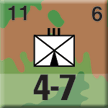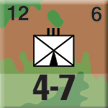Alsace 1945:
Evil Mountaineers
By Mike Bennighof, Ph.D.
April 2015
The SS Division Nord entered combat in June 1941 and immediately
gained a reputation as the worst combat formation in the German
armed forces. The Nord unit went into action in central Finland,
at first on the Salla front and then at Kestenga.
Nord had been formed from two “standarten” of
the SS, occupation troops happily terrorizing the people of
Prague and Brno in Czechoslovakia. The “combat group”
went to northern Norway in April and May 1941, and transferred
into Finland in early June. On the 17th Nord officially became
a motorized infantry division and received a new command staff,
and on the 29th the SS men had their first taste of combat
at Salla.  Even the division’s veterans call Salla a disaster,
and the reality is worse. Terrified Aryans ran screaming into
the thick forests, some never to be seen again, while other
panicked SS men showed up at Army headquarters dozens of miles
behind the front. The thick forests and heavy smoke from forest
fires disoriented the troops, and when faced with actual armed
opponents instead of Czech civilians, the unit completely
fell apart. Even the division’s veterans call Salla a disaster,
and the reality is worse. Terrified Aryans ran screaming into
the thick forests, some never to be seen again, while other
panicked SS men showed up at Army headquarters dozens of miles
behind the front. The thick forests and heavy smoke from forest
fires disoriented the troops, and when faced with actual armed
opponents instead of Czech civilians, the unit completely
fell apart.
SS Nord did little better when it returned to combat at Kestenga
later in the year. By the end of 1941, it had suffered severe
casualties. Over the winter of 1941-42 it received replacements
from the general pool of Waffen SS recruits, supposedly younger
and better trained than the SS-men of the original formation.
SS Nord officially became a mountain division in January 1942,
and later in 1942 became the 6th SS Mountain Division “Nord.”
The rebuilt division fought against the Soviet spring offensive
in 1942 and this time managed to hold its lines. Throughout
the rest of 1942 and through 1943 it remained on the Kestenga
front, which now became a quiet backwater. The German high
command never seriously contemplated withdrawing the SS division,
indicating that its combat reputation remained low.  In the summer of 1944 the Soviets opened a massive offensive
on all parts of the Finnish front, including the Kestenga
sector. SS Nord held its lines in heavy fighting, until ordered
to withdraw from Finland. At this point, Nord’s troopers
proved they were indeed SS men, burning down the Finnish town
of Rovaniemi as they passed through (the act was probably
committed by Norwegian SS volunteers, though Rovaniemi was
the site of the division’s 1941 disgrace, when Nord
troopers showed up at Army headquarters there claiming Soviet
tanks were hot on their heels). SS Nord clashed with the Finnish
11th Division as it headed toward Norway, and a special order
from Heinrich Himmler, head of the SS, was read to the division’s
troops promising reprisals against the family members of anyone
who took advantage of the situation to defect to Sweden. In the summer of 1944 the Soviets opened a massive offensive
on all parts of the Finnish front, including the Kestenga
sector. SS Nord held its lines in heavy fighting, until ordered
to withdraw from Finland. At this point, Nord’s troopers
proved they were indeed SS men, burning down the Finnish town
of Rovaniemi as they passed through (the act was probably
committed by Norwegian SS volunteers, though Rovaniemi was
the site of the division’s 1941 disgrace, when Nord
troopers showed up at Army headquarters there claiming Soviet
tanks were hot on their heels). SS Nord clashed with the Finnish
11th Division as it headed toward Norway, and a special order
from Heinrich Himmler, head of the SS, was read to the division’s
troops promising reprisals against the family members of anyone
who took advantage of the situation to defect to Sweden.
The SS men proceeded from the Norwegian border south to Denmark
by foot, train and ship. The division was slated for participation
in the German offensive in the Ardennes known as the Battle
of the Bulge, but did not assemble in Aarhus, Denmark, until
20 December, several days after the attack had already begun.
Instead, the division was alloted to Operation Nordwind in
Alsace.
SS Nord by this point consisted of two mountain infantry regiments,
the 11th (named for the war criminal Reinhard Heydrich, executed
by partisans in 1942 but known personally to many of the regiment’s
older veterans from their time in Prague) and 12th (which
stained the name of Michael Gaissmaier, a 16th-century Tirolese
war hero). As a holdover from its days as a motorized infantry
division, Nord also included the 506th SS Panzer Grenadier
Battalion, a motorized infantry unit usually deployed as the
divisional reserve.
 The Norwegian 504th SS Ski Battalion had also been part of
the division in Finland, but remained in Norway when the rest
of the division headed south. One of the odder aspects of
the Waffen SS as an institution is that despite a near-total
disregard for international law and a lengthy list of war
crimes, it honored its commitment not to deploy the Norwegian
volunteers against anyone but the Soviet Union (though the
ski battalion did fight the Finns during the retreat). The Norwegian 504th SS Ski Battalion had also been part of
the division in Finland, but remained in Norway when the rest
of the division headed south. One of the odder aspects of
the Waffen SS as an institution is that despite a near-total
disregard for international law and a lengthy list of war
crimes, it honored its commitment not to deploy the Norwegian
volunteers against anyone but the Soviet Union (though the
ski battalion did fight the Finns during the retreat).
In Denmark, the troops received additional weapons and new
uniforms before arriving at the front lines just before New
Year’s Day. Nord was the largest German division involved
in Nordwind, and it had young and fit personnel compared to
regular Army outfits. By 2 January, part of the division (12th
Regiment and 506th Battalion), attached to 361st Volksgrenadier
Division, went into action against the
U.S. 45th Infantry Division. For six days the SS men fought in and around the
town of Wingen, finally being pushed back by the Americans
with most of the battle group killed or captured.
On the 16th, the 11th SS Mountain Regiment surrounded six
companies of the American 157th Infantry Regiment. The Americans
surrendered three days later, losing 482 men, and the entire
SS division advanced for four more days before being mauled
by American counterattacks.
The SS mountain division remained on the western front after
the Nordwind offensive, fighting the Americans around Trier
on the Moselle River in March before going into 7th Army’s
reserve in April. By this point the division had lost most
of its heavy weapons (officially to fuel shortages) and was
grossly understrength. In May 1945, the unit’s survivors
surrendered to the Americans.
Sixty years later, despite overwhelming documentation to the
contrary, a sad myth persists that the Waffen SS was an elite
fighting force of common soldiers who had nothing to do with
Adolf Hitler’s program of mass murder. While Nord may
have lacked the criminal record of better-known units, this
was mostly due to lack of opportunity: there were few Jews
to massacre in the Arctic wilderness, and the unit went immediately
into combat on the Western front where it was smashed by the
Americans, as shown in our Alsace
1945 game.
Order
now to deploy these cowards in Alsace 1945.
Mike Bennighof is president of Avalanche Press and holds a doctorate in history from Emory University. A Fulbright Scholar and award-winning journalist, he has published over 100 books, games and articles on historical subjects.
He lives in Birmingham, Alabama with his wife, three children and his dog, Leopold. |
